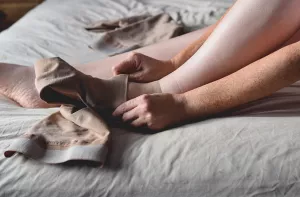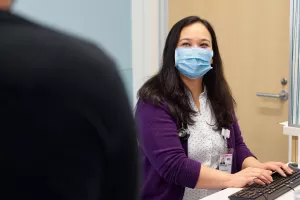Lymphedema causes swelling in your arms, legs, breasts, chest, head or neck. It happens when fluid builds up under your skin, making the area feel heavy or tight. A certified lymphedema therapist can help manage symptoms with massage, compression and movement.
Going with the flow to treat lymphedema
The lymphatic system is part of your body’s circulatory system. Think of it like a water treatment plant — it helps drain extra fluid, waste and toxins through 600–700 lymph nodes that clean and return the fluid to your bloodstream.
When that system gets blocked and fluid builds up, it can lead to lymphedema. It often develops after cancer treatment, surgery or injury, but it can happen on its own, too.
There’s no cure yet, but a certified lymphedema therapist can help manage pain and swelling with treatments like gentle massage, compression and movement. The sooner you get care, the easier it can be to manage symptoms. Many people live well with lymphedema and our team is here to support you in feeling your best.

Conditions
Lymphedema is a condition that causes swelling, and it can happen in two ways, depending on the cause:
- Primary lymphedema: Also known as congenital lymphedema, this type can be inherited from birth or develop during puberty or adulthood. The cause is unknown. Common signs include swelling, tightness or a feeling of heaviness in the affected area.
- Secondary lymphedema: This is the more common type. It happens when the lymphatic system is disrupted by factors like surgery, radiation, infection or injury. It often affects areas like the arms or legs.
In particular, breast cancer survivors are at a higher risk of developing lymphedema, especially if they’ve had lymph nodes removed. That’s why it’s important to stay on top of your breast health, even years after being declared cancer-free.
Regardless of the type, a certified lymphedema therapist can help manage symptoms and improve your quality of life.
The most common and noticeable symptom of lymphedema is swelling. It’s easier to treat when caught early, so it’s important to talk to your doctor if you notice any of these symptoms:
- Arms, legs or other areas feeling uncomfortably heavy or "full"
- Clothing or jewelry fitting tightly
- Numbness or tingling in the arms or legs
- Swelling
- Tight and inflexible joints
Treatments
Lymphedema is a lifelong condition, but that doesn’t mean you have to live with pain and discomfort. We can help manage swelling with the right treatments.
With the proper exercises and care, we can improve your movement and daily tasks. We use Complete Decongestive Therapy (CDT) as the core treatment plan. CDT includes:
- Compression bandaging and clothing
- Exercises
- Manual lymphatic drainage
- Skin and nail care
The key to managing lymphedema is knowledge. We’ll provide the resources and guidance you need to manage your condition comfortably at home.

From regular office visits to inpatient stays, find the healthcare you need and deserve close to home.

Meet the doctors and care team devoted to supporting you every step of the way along your path to better health.